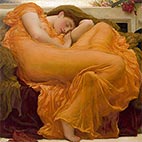
Victorian Neoclassicism and Romanticism Artists Index
Alphabetical Index of the Great Masters of Victorian Neoclassicism and Romanticism
Victorian Neoclassicism and Romanticism are two significant art movements that emerged in the late 18th and early 19th centuries. Neoclassicism, also known as Classicism, began in the 1760s and lasted until the 1840s and 50s. Neoclassical art aimed to revive the classical styles of ancient Greece and Rome. Neoclassical artists sought to create a style that was rational, balanced, and orderly, and that emphasized the values of clarity, simplicity, and symmetry. It was often used to convey moral and intellectual values, and was seen as a way of elevating the middle class.
On the other hand, Romanticism, a movement that celebrated emotion, individualism, and the imagination, emerged in the late 18th century as a reaction against the rationalism and strict rules of neoclassicism. Romantic artists sought to explore the world of the subconscious and the mystical and often depicted powerful emotions, nature, and the exotic. It can be seen as a rejection of the precepts of order, calm, harmony, balance, idealization, and rationality that typified Classicism in general and late 18th-century Neoclassicism in particular. Romanticism was often used to convey a sense of escapism and to explore themes of the supernatural and the irrational.
In the Victorian era (1837-1901) in England, both Victorian Neoclassicism and Romanticism had a significant impact on art and culture, shaping the visual language of the era. Victorian Neoclassical artists like Sir Lawrence Alma-Tadema, Frederic Leighton, and John William Waterhouse created idealized images of the classical world, often with a focus on history and mythology. In contrast, Victorian Romantic artists like William Blake, J.M.W. Turner, and John Constable explored themes of emotion, nature, and the sublime. Blake, a poet as well as a painter, was a prime example of the Romantic artist, believing in the power of the imagination and the ability of art to convey profound ideas and emotions.
On the other hand, Romanticism, a movement that celebrated emotion, individualism, and the imagination, emerged in the late 18th century as a reaction against the rationalism and strict rules of neoclassicism. Romantic artists sought to explore the world of the subconscious and the mystical and often depicted powerful emotions, nature, and the exotic. It can be seen as a rejection of the precepts of order, calm, harmony, balance, idealization, and rationality that typified Classicism in general and late 18th-century Neoclassicism in particular. Romanticism was often used to convey a sense of escapism and to explore themes of the supernatural and the irrational.
In the Victorian era (1837-1901) in England, both Victorian Neoclassicism and Romanticism had a significant impact on art and culture, shaping the visual language of the era. Victorian Neoclassical artists like Sir Lawrence Alma-Tadema, Frederic Leighton, and John William Waterhouse created idealized images of the classical world, often with a focus on history and mythology. In contrast, Victorian Romantic artists like William Blake, J.M.W. Turner, and John Constable explored themes of emotion, nature, and the sublime. Blake, a poet as well as a painter, was a prime example of the Romantic artist, believing in the power of the imagination and the ability of art to convey profound ideas and emotions.